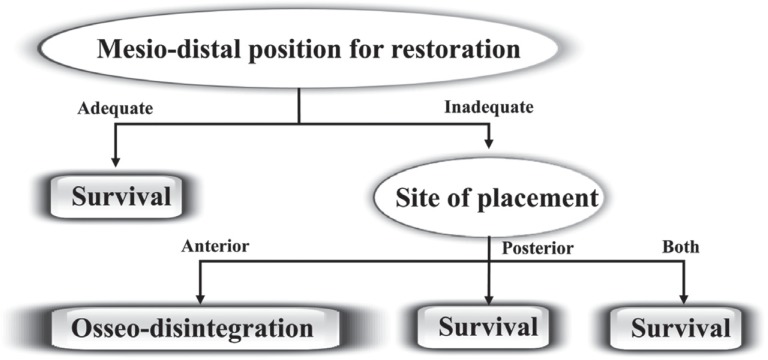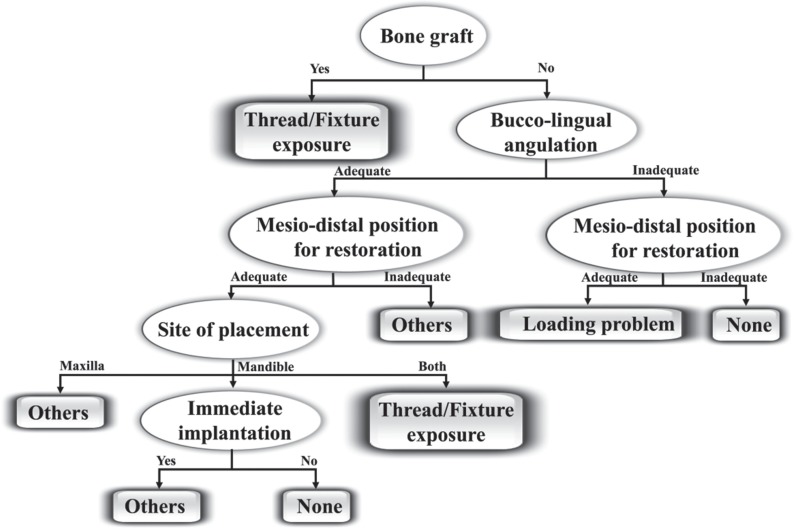J Adv Prosthodont.
2018 Dec;10(6):395-400. 10.4047/jap.2018.10.6.395.
A pilot study using machine learning methods about factors influencing prognosis of dental implants
- Affiliations
-
- 1Department of Prosthodontics, Dankook University College of Dentistry Jukjeon Dental Hospital, Yongin, Republic of Korea.
- 2Private Practice, The Seoul Dental Clinic, Seongnam, Republic of Korea.
- 3Biomedical Knowledge Engineering Lab., Seoul National University School of Dentistry, Seoul, Republic of Korea.
- 4Dental Research Institute, Seoul National University School of Dentistry, Seoul, Republic of Korea.
- 5Private Practice, Yang's Dental Clinic, Seoul, Republic of Korea.
- 6Department of IT Engineering, Hansung University, Seoul, Republic of Korea.
- 7Department of Prosthodontics and Dental Research Institute, Seoul National University School of Dentistry, Seoul, Republic of Korea. pros53@snu.ac.kr
- KMID: 2429371
- DOI: http://doi.org/10.4047/jap.2018.10.6.395
Abstract
- PURPOSE
This study tried to find the most significant factors predicting implant prognosis using machine learning methods.
MATERIALS AND METHODS
The data used in this study was based on a systematic search of chart files at Seoul National University Bundang Hospital for one year. In this period, oral and maxillofacial surgeons inserted 667 implants in 198 patients after consultation with a prosthodontist. The traditional statistical methods were inappropriate in this study, which analyzed the data of a small sample size to find a factor affecting the prognosis. The machine learning methods were used in this study, since these methods have analyzing power for a small sample size and are able to find a new factor that has been unknown to have an effect on the result. A decision tree model and a support vector machine were used for the analysis.
RESULTS
The results identified mesio-distal position of the inserted implant as the most significant factor determining its prognosis. Both of the machine learning methods, the decision tree model and support vector machine, yielded the similar results.
CONCLUSION
Dental clinicians should be careful in locating implants in the patient's mouths, especially mesio-distally, to minimize the negative complications against implant survival.
MeSH Terms
Figure
Reference
-
1. Academy of Osseointegration. 2010 Guidelines of the Academy of Osseointegration for the provision of dental implants and associated patient care. Int J Oral Maxillofac Implants. 2010; 25:620–627. PMID: 20653117.2. Kohner JS. Implant team: problems and solutions with osseointegrated implants. Pract Periodontics Aesthet Dent. 1992; 4:27–32.3. Garber DA, Belser UC. Restoration-driven implant placement with restoration-generated site development. Compend Contin Educ Dent. 1995; 16:796798–802. 804PMID: 8620398.4. Bryant SR. The effects of age, jaw site, and bone condition on oral implant outcomes. Int J Prosthodont. 1998; 11:470–490. PMID: 9922739.5. Omran MT, Miley DD, McLeod DE, Garcia MN. Retrospective assessment of survival rate for short endosseous dental implants. Implant Dent. 2015; 24:185–191. PMID: 25706268.
Article6. Tolstunov L. Implant zones of the jaws: implant location and related success rate. J Oral Implantol. 2007; 33:211–220. PMID: 17912962.
Article7. Walton JN, MacEntee MI. Choosing or refusing oral implants: a prospective study of edentulous volunteers for a clinical trial. Int J Prosthodont. 2005; 18:483–488. PMID: 16335167.
Article8. Furey TS, Cristianini N, Duffy N, Bednarski DW, Schummer M, Haussler D. Support vector machine classification and validation of cancer tissue samples using microarray expression data. Bioinformatics. 2000; 16:906–914. PMID: 11120680.
Article9. Mitchell TM. Machine Learning. New York: McGraw-Hill;1997. p. 414.10. Gambhir SS, Hoh CK, Phelps ME, Madar I, Maddahi J. Decision tree sensitivity analysis for cost-effectiveness of FDG-PET in the staging and management of non-small-cell lung carcinoma. J Nucl Med. 1996; 37:1428–1436. PMID: 8790186.11. Nakano Y, Takeshita T, Kamio N, Shiota S, Shibata Y, Suzuki N, Yoneda M, Hirofuji T, Yamashita Y. Supervised machine learning-based classification of oral malodor based on the microbiota in saliva samples. Artif Intell Med. 2014; 60:97–101. PMID: 24439218.
Article12. Ward JJ, McGuffin LJ, Buxton BF, Jones DT. Secondary structure prediction with support vector machines. Bioinformatics. 2003; 19:1650–1655. PMID: 12967961.
Article13. Chen J, Xing Y, Xi G, Chen J, Yi J, Zhao D, Wang J. A comparison of four data mining models: Bayes, neural network, SVM and decision trees in identifying syndromes in coronary heart disease. Advances in Neural Networks-ISNN 2007. Springer;2007. p. 1274–1279.14. Bullinger D, Fröhlich H, Klaus F, Neubauer H, Frickenschmidt A, Henneges C, Zell A, Laufer S, Gleiter CH, Liebich H, Kammerer B. Bioinformatical evaluation of modified nucleosides as biomedical markers in diagnosis of breast cancer. Anal Chim Acta. 2008; 618:29–34. PMID: 18501242.
Article15. Fung G, Stoeckel J. SVM feature selection for classification of SPECT images of Alzheimer's disease using spatial information. Knowl Inf Syst. 2007; 11:243–258.
Article16. Son YJ, Kim HG, Kim EH, Choi S, Lee SK. Application of support vector machine for prediction of medication adherence in heart failure patients. Healthc Inform Res. 2010; 16:253–259. PMID: 21818444.
Article17. Hwang D, Wang HL. Medical contraindications to implant therapy: part I: absolute contraindications. Implant Dent. 2006; 15:353–360. PMID: 17172952.
Article18. Hwang D, Wang HL. Medical contraindications to implant therapy: Part II: Relative contraindications. Implant Dent. 2007; 16:13–23. PMID: 17356368.
Article19. Michalski RSE, Carbonell JGE, Mitchell TME. Machine learning: an artificial intelligence approach. New York: Springer-Verlag;1984.20. Samuel AL. Some studies in machine learning using the game of checkers. IBM J Res Dev. 2000; 44:206–226.
Article21. Freitag D. Machine learning for information extraction in informal domains. Mach Learn. 2000; 39:169–202.22. Sebastiani F. Machine learning in automated text categorization. Acm Comput Surv. 2002; 34:1–47.
Article23. Ivanoff CJ, Sennerby L, Johansson C, Rangert B, Lekholm U. Influence of implant diameters on the integration of screw implants. An experimental study in rabbits. Int J Oral Maxillofac Surg. 1997; 26:141–148. PMID: 9151173.24. Winkler S, Morris HF, Ochi S. Implant survival to 36 months as related to length and diameter. Ann Periodontol. 2000; 5:22–31. PMID: 11885179.
Article25. Lin S, Shi S, LeGeros RZ, LeGeros JP. Three-dimensional finite element analyses of four designs of a high-strength silicon nitride implant. Implant Dent. 2000; 9:53–60. PMID: 11307234.
Article
- Full Text Links
- Actions
-
Cited
- CITED
-
- Close
- Share
- Similar articles
-
- Feasibility Study of Google’s Teachable Machine in Diagnosis of Tooth-Marked Tongue
- The application of machine learning for predicting recurrence in patients with early-stage endometrial cancer: a pilot study
- The Relationship between Metacognition, Learning Flow, and Problem-Solving Ability of Dental Hygiene Students
- Application of Machine Learning in Rhinology: A State of the Art Review
- Attention Sustentation Test in Children with Learning Disables-A Pilot Study



